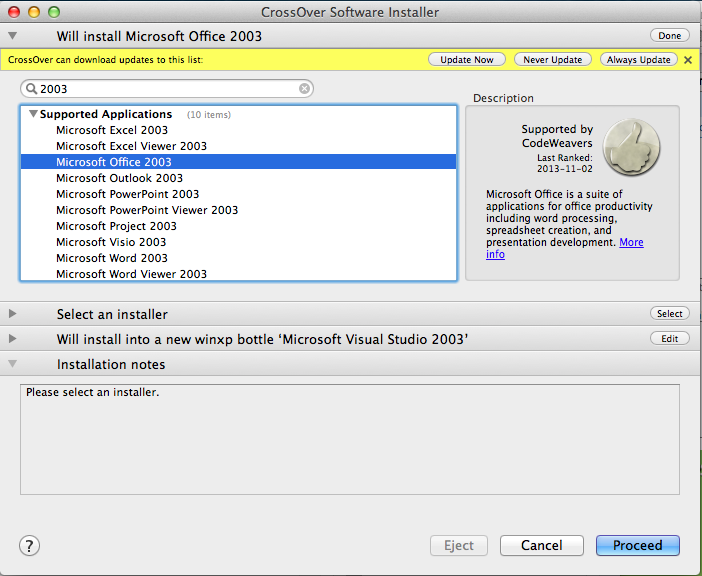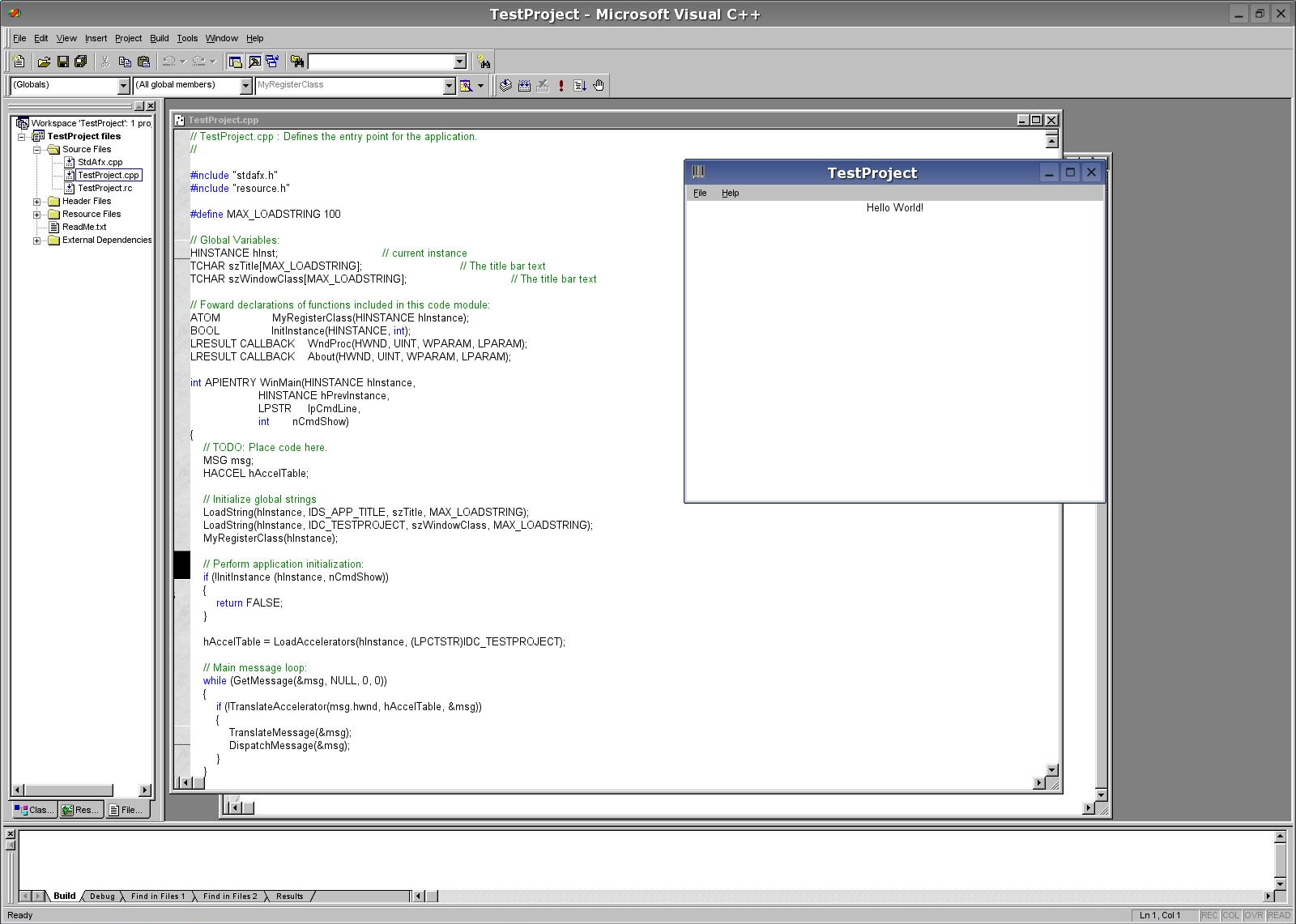Visual Studio for Mac is a powerful developer tool that reinforces Microsoft’s “mobile-first”, “cloud-first”, and “any developer, any platform, any device” strategy. With the author's guided expertise and extensive code samples, you will understand how to leverage the most useful tools in Visual Studio for Mac, the code editor. Visual Studio for Mac is a macOS-native.NET IDE that focuses on.NET Core, Xamarin, and Unity. It provides many of the same features as Visual Studio for Windows, such as a shared C#, XAML, and web editor. For more information on Visual Studio for Mac, see our documentation. Before writing any code, you’ll first need to. Download Visual Studio Community, Professional, and Enterprise. Try Visual Studio IDE, Code or Mac for free today. CrossOver works differently. It's not an emulator. It does the work of translating Windows commands into Mac commands so that you can run Windows software as if it were designed native to Mac. CrossOver works with all kinds of software - productivity software, utility programs, and games - all with one application. Better experience.
Installation
- Download Visual Studio Code for macOS.
- Open the browser's download list and locate the downloaded archive.
- Select the 'magnifying glass' icon to open the archive in Finder.
- Drag
Visual Studio Code.appto theApplicationsfolder, making it available in the macOS Launchpad. - Add VS Code to your Dock by right-clicking on the icon to bring up the context menu and choosing Options, Keep in Dock.
Launching from the command line
You can also run VS Code from the terminal by typing 'code' after adding it to the path:
- Launch VS Code.
- Open the Command Palette (Cmd+Shift+P) and type 'shell command' to find the Shell Command: Install 'code' command in PATH command.
- Restart the terminal for the new
$PATHvalue to take effect. You'll be able to type 'code .' in any folder to start editing files in that folder.
Note: If you still have the old code alias in your .bash_profile (or equivalent) from an early VS Code version, remove it and replace it by executing the Shell Command: Install 'code' command in PATH command.
Alternative manual instructions
Instead of running the command above, you can manually add VS Code to your path, to do so run the following commands:
Start a new terminal to pick up your .bash_profile changes.
Note: The leading slash is required to prevent $PATH from expanding during the concatenation. Remove the leading slash if you want to run the export command directly in a terminal.
Note: Since zsh became the default shell in macOS Catalina, run the following commands to add VS Code to your path:

Touch Bar support
Out of the box VS Code adds actions to navigate in editor history as well as the full Debug tool bar to control the debugger on your Touch Bar:
Mojave privacy protections
After upgrading to macOS Mojave version, you may see dialogs saying 'Visual Studio Code would like to access your {calendar/contacts/photos}.' This is due to the new privacy protections in Mojave and is not specific to VS Code. The same dialogs may be displayed when running other applications as well. The dialog is shown once for each type of personal data and it is fine to choose Don't Allow since VS Code does not need access to those folders. You can read a more detailed explanation in this blog post.
Updates
VS Code ships monthly releases and supports auto-update when a new release is available. If you're prompted by VS Code, accept the newest update and it will get installed (you won't need to do anything else to get the latest bits).
Note: You can disable auto-update if you prefer to update VS Code on your own schedule.
Preferences menu
You can configure VS Code through settings, color themes, and custom keybindings available through the Code > Preferences menu group.
You may see mention of File > Preferences in documentation, which is the Preferences menu group location on Windows and Linux. On a macOS, the Preferences menu group is under Code, not File.
Next steps
Once you have installed VS Code, these topics will help you learn more about VS Code:
- Additional Components - Learn how to install Git, Node.js, TypeScript, and tools like Yeoman.
- User Interface - A quick orientation around VS Code.
- User/Workspace Settings - Learn how to configure VS Code to your preferences settings.
Common questions

Why do I see 'Visual Studio Code would like access to your calendar.'
If you are running macOS Mojave version, you may see dialogs saying 'Visual Studio Code would like to access your {calendar/contacts/photos}.' This is due to the new privacy protections in Mojave discussed above. It is fine to choose Don't Allow since VS Code does not need access to those folders.
VS Code fails to update
If VS Code doesn't update once it restarts, it might be set under quarantine by macOS. Follow the steps in this issue for resolution.
Does VS Code run on Mac M1 machines?
Yes, VS Code supports macOS ARM64 builds that can run on Macs with the Apple M1 chip. You can install the Universal build, which includes both Intel and Apple Silicon builds, or one of the platform specific builds.
Visual Studio has not always been as user-friendly on the Mac as it is on a Windows machine. Lately, however, the stable release of VS for Mac is really starting to feel like a simple, but luxurious cousin to Visual Studio 2019. Different, but related. Installation on a Mac is quick, simple, and allows you to get into coding right away - whether you are already familiar or an Apple-only dev getting into something new like Xamarin.
Visual Studio for Mac bears a striking similarity to xCode’s solution navigation feel, but brings the power of VS intellisense and an ability to focus on your code in a much cleaner looking environment. In my opinion, this brings the best of both worlds together. But don’t take my word for it: here are five reasons to give Visual Studio for Mac another go!
1. The C# Editor in Visual Studio for Mac is Completely New
Roslyn, the .NET compiler platform, is now in the Visual Studio for Mac editor - making your intellisense as powerful as its big brother on Windows. Marrying the functionality ported over from the Roslyn compiler with the (frankly, beautiful looking) simplicity of a native-feeling Mac UI editing experience gives this girl all the feels. It has full support for third-party Nuget packages for .NET Core (utilizing .NET Standard) along with Unity, Xamarin and Cocoa apps.
I didn’t notice a big difference gating my progress of a .NET Core app. At this point, I don’t know why I would switch over to a windows VM in order to build a microservice API in .NET Core at all!
Finally, I’m loving that VS for Mac now includes “Go to implementation” as an option in the latest release. Exciting! The C# experience is pretty great now.

2. CLI Developers Can Open .NET Core Projects in Terminal
Ah, the command line. Many developers love using it for .NET Core instead of the “visual” click and drag aspect of the Visual Studio IDE. At first, the use of command line programming with ASP.NET Core was the only way you could build those apps. Over time, and especially with the release of Visual Studio 2019, the File > New Project templates for ASP.NET Core apps have been baked into the install bringing a truly visual experience to that build.
For a while, it was unclear if the same command line net new project CLI functionality would be available on Mac, but I am happy to report that it is and it works beautifully! The use of the Terminal app brings that experience to you harcore command line devs.
3. Improved Build Time for Xamarin
Remember those build and deploy coffee breaks? Well say goodbye (unless you don’t want to of course). On one of my Xamarin projects I saw a super impressive 30% faster incremental build time. That’s not an insignificant improvement.
This metric is also supported by the April 2019 press release from the VS for Mac team. I used to design my development process in such a way that I could multitask to stay efficient and productive. I’m happy to report those days are gone with much improved build speeds, making the Xamarin app building process something I can say I truly enjoy.
4. .NET Core 3 Support Available Right Out of the Gate
Does Visual Studio 2019 have .NET Core 3 support? Yes, but that’s no reason to jump over to your Windows machine! You can use all the same, wonderful new stuff on your Apple machine, too.
In fact, I’d argue that Visual Studio for Mac is an excellent place to start learning how to build apps for .NET Core 3. With fewer small windows everywhere like it’s Windows-based cousin, VS for Mac allows for a more-focused process.
5. Robust Source Control Options
This is where some “same but different” comes into play. I find that developers coming over from Swift or Objective C development enjoy the experience of source control within Visual Studio for Mac. While there IS a difference in the process for Windows users, I don’t find it particularly difficult. Visual Studio for Mac supports Git and Subversion built into the IDE, as well as TFS with a little more effort.
I have used the Github Desktop app for source control of my folders without much issue. This is also my source control workflow for VS Code, and while it is not integrated into the IDE of VS for Mac, it’s also not a bad option. For the hardcore command line peeps, you can alternatively use Git inside the CLI tool Terminal, which is native to Apple OS. There is no learning curve here at all for developers who use command line.
Who Should Use Visual Studio for Mac?
Visual Studio for Mac is a strong choice for many developers and many use cases. Here are a few that come to mind:
Crossover Mac Visual Studio Code
.NET users building Xamarin mobile apps that require IOS builds will benefit tremendously from having all their development on a single machine.
Developers working with .NET Core, who love working on a Mac, and currently use a virtual machine or Bootcamp to run Visual Studio in a windows environment will benefit from not having to switch over from the Apple operating system constantly.
Unity game developers will find VS for Mac be very intuitive option.
The last group to come over will be .NET Framework developers who have worked with Visual Studio on Windows as their only option for .NET 4.7.2 for example. Sadly no, .NET Framework cannot run on VS for Mac. However, once you are ready to start building your apps or microservices in .NET Core - check it out!
New functionality, extensions and templates are all coming this next year to Visual Studio for Mac that make living in harmony with Apple + Microsoft a real joy.
Crossover Mac Visual Studio Code
Learn More About .NET Core, Xamarin, Apple & OAuth
If you’d like to learn more about ASP.NET, Xamarin, or Apple, we’ve also published a number of posts that might interest you:
For other great content from the Okta Dev Team, follow us on Twitter and Facebook!